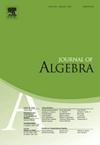Interpolation of open-closed TQFTs
IF 0.8
2区 数学
Q2 MATHEMATICS
引用次数: 0
Abstract
For any symmetric monoidal category , Lauda and Pfeiffer showed the equivalence between the -valued open-closed 2-dimensional TQFTs and the so-called knowledgeable Frobenius algebras (kFAs) in . A kFA in the category of finite-dimensional vector spaces over a field provides a sequence of scalars indexed by the set of diffeomorphism classes of connected endocobordisms of the empty set, given by evaluation of the associated TQFT on each such cobordism class. More generally, from an arbitrary sequence , we show how to build a symmetric monoidal category , with unit object 1 satisfying , generated by a kFA affording this sequence. We then determine which sequences χ produce semisimple abelian categories with finite-dimensional hom-spaces. These categories generalise results of Deligne concerning the interpolation of families of categories of representations such as , , and .
开闭tqft的插补
对于任意对称一元范畴C, Lauda和Pfeiffer证明了C值开闭二维TQFT与C中所谓的知识Frobenius代数(kFA)之间的等价性。域K上有限维向量空间范畴中的kFA提供了由空集合的连通内共体的微分同态类的集合N2索引的标量序列,该序列由每个这样的共体类上的相关TQFT的评估给出。更一般地说,从任意序列χ=(χg,w)g,w∈N,我们展示了如何构建一个对称的一元范畴< TkFA|χ >,其单位对象1满足End(1) × K,由提供该序列的kFA生成。然后,我们确定哪些序列χ产生具有有限维主空间的半简单阿贝尔范畴< TkFA|χ >。这些类别概括了Deligne关于表示的类别族的插值结果,如Rep(Sd), Rep(Od)和Rep(Sη献祭PGLd)。
本文章由计算机程序翻译,如有差异,请以英文原文为准。
求助全文
约1分钟内获得全文
求助全文
来源期刊

Journal of Algebra
数学-数学
CiteScore
1.50
自引率
22.20%
发文量
414
审稿时长
2-4 weeks
期刊介绍:
The Journal of Algebra is a leading international journal and publishes papers that demonstrate high quality research results in algebra and related computational aspects. Only the very best and most interesting papers are to be considered for publication in the journal. With this in mind, it is important that the contribution offer a substantial result that will have a lasting effect upon the field. The journal also seeks work that presents innovative techniques that offer promising results for future research.
 求助内容:
求助内容: 应助结果提醒方式:
应助结果提醒方式:


